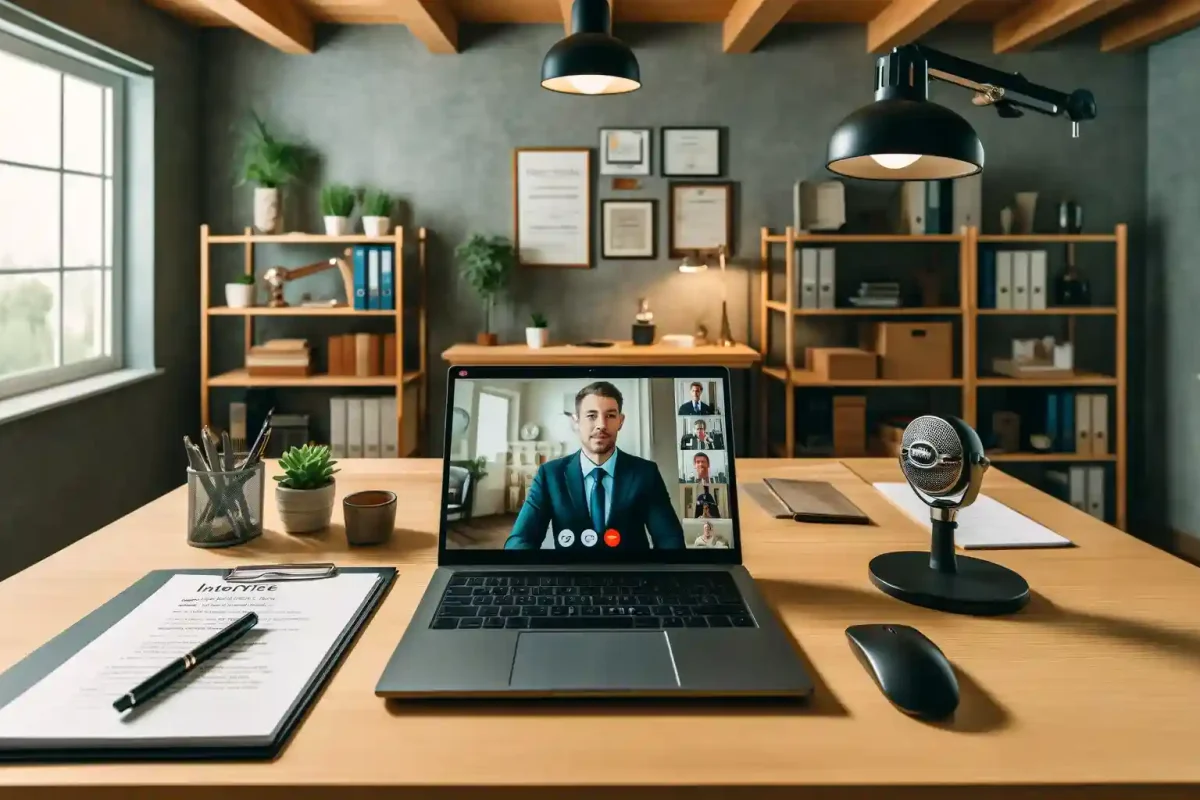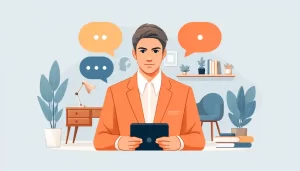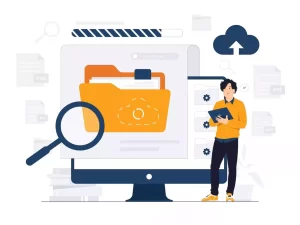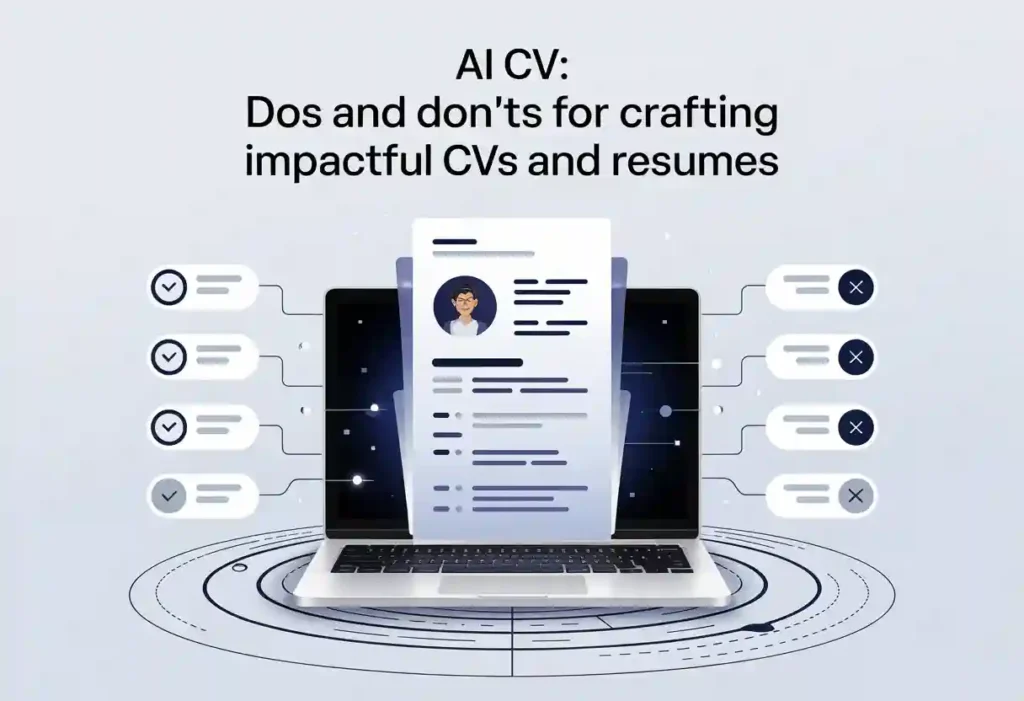How to Prepare for Your Video Interview
You may be tempted to think a video chat interview is not an interview. But it is. That means you have to prepare as much as you would for an in-person interview.
Of course, you don’t have to fuss about driving to the firm and finding the right office on time. But the interviewer still expects you to bring your A-game.
Here is how you can do that:
1. Establish and Test Your Setup
The first thing a hiring manager communicates about an in-person interview is the time and location.
You get the time in video interviews but must set up the “location” yourself.
This begins with finding out what video platform you will use for the interview.
Common online video interview platforms include Skype, Zoom, Google Meet, WebEx, and Microsoft Teams.
Next, you need to familiarize yourself with how the platform works.
Watch a quick tutorial to start and end a session, turn on and mute your microphone, turn on the camera, share your screen, and more.
You can then set up the following technical aspects of your video interview.
- Internet Connection
You need a strong and secure internet connection since your interview will happen online.
Check that only a few devices are connected to your WiFi and that you are not streaming videos in the background.
These factors could cause video and sound interruptions during your interview.
Pro-Tip
If possible, avoid public WiFi. It could be weak and unreliable.
Lighting
Think of that friend video chat last week where your friend kept asking you to move because they couldn’t see you. You want to avoid that in your interview.
Assess your home to find the best-lit area to have your interview.
Your options include setting up next to a window with a natural light source or in a room with at least two artificial lamps.
Make sure the artificial or natural light is in front of you. Placing it behind you can create shadows, making you look like a silhouette.
Shot
We have already established that you, not the hiring manager, are in charge of the location.
So next, you need to create an excellent physical shot for your interview. Find a quiet space in your home with a neutral background away from decorations or clutter.
You can use a blank wall or a book-lined section of your home office.
Allow at least two feet of space between you and the background for optimal lighting and little shadows.
You also need to position your camera just above your eyeline. Too high or too low, you will be out of shot or peering at the interviewer.
Sound
Technology has come a long way. A video call can make it seem like you are in the same room as the other person.
But you are not, meaning they can only hear you if your mic works appropriately.
Do a mock video interview with a career coach or one of your friends and ask them to take note of how you speak.
Are you audible at all times? Do your pace, pitch, and tone convey excitement and confidence?
Fix any sound problems you discover and seal the deal by speaking naturally and at a reasonable pace.
Glare
Confirm that nothing in your physical setup produces glare or reflects on the lens.
This can be distracting to the interviewer. You want to look out for eyeglasses, vases, jewelry, watches, and other shiny objects.
If you notice a glare:
- Adjust the angle of your laptop by moving the screen up or down
- Use a lampshade
- Point your light source at a wall and away from yourself
Position
You also want to sit at a comfortable distance from your laptop. The goal here is not to look too small or too large.
To achieve this, position yourself so there is space above your head on the screen and your upper chest and shoulders are in the video frame.
Eye Contact
Have you ever tried to talk to someone who was looking at their shoes the entire time?
Did it feel like they were interested in what you were saying? Unlikely.
You may not be able to maintain eye contact with interviewers in virtual interviews, but you can do the next best thing: look at their faces.
Place your computer so you look straight ahead at the interviewer, not the camera.
Centre your window so that you are also peering into the camera when you look at it.
That way, you maintain “eye contact” while appearing natural.
Frame
Finally, scan your background. What is behind you?
Remember, you want the interviewer to consider you as organized and professional.
This can be difficult if a pile of unsorted books is lying behind you.
You also want to avoid any mirrors that could reflect unflattering areas of the room.
Pro-Tip
If a bookshelf is behind you, scan the titles to ensure nothing unprofessional is displayed.

2. Prepare Your Location
Considering all the factors above, you now have a location for your virtual interview. You now need to eliminate all interruptions.
You can start by notifying anyone you live with to maintain silence and not disturb you during your video call job interview.
You can also wear headphones to improve the sound quality and turn off your phone and computer notifications.

3. Dress the Part
In-person interviews often require you to dress the part. You may not see the point of doing the same for video interviews.
After all, they cannot see beyond your chest. No.
One of the best career advice you will get is to always dress for the job you want.
This means dressing formally from head to toe for a virtual interview, even if the interviewer might not see your outfit.
Dressing correctly gives you the confidence to ace your job interview. It communicates that you are serious about the job.
There is also always a chance that the interviewer may ask you to fetch something during the interview.
It will not help your options if you stand up in your pajamas.
When choosing what to wear, check whether it looks good on camera.
Does that low-cut shirt make you appear naked on screen? Wear something that covers well.
You should also wear neutral colors like brown, grey, navy, and black, and avoid distracting patterns.
Similarly, keep your jewelry, make-up, and hair simple.
Like this post?
Sign up for our blog updates and never miss a post.
We’ll send you A FREE job interview eBook as a thank-you.
4. Research
What you say during your interview is as crucial as how you look.
Your next step is to research the company and the job. Learn everything about the company’s history, culture, and achievements.
Peruse the job description and identify what the recruiter is looking for, including critical soft and hard skills.
You can also make a few prompts to help you during the job interview. Here are some thinking points to help you:
Consider the type of questions the recruiter might ask you.
Use the STAR method to craft your answers.
Consider what you will ask the interviewer and determine how many interview questions to ask. For example, you can ask them what to expect from a typical day at the office.
Common Video and In-Person Interview Questions: How to Answer
As you research, it might help to understand what the interviewer might ask you during your video interview.
What are the typical video interview-focused questions you might hear?
How should you answer them? Typically, the interviewer will ask you questions about the following:
You: This is not an opportunity to launch into a monologue about your pets or skiing holidays. The best way to answer this question is by defining your interests in the industry. How has your life led you to this job? Why do you do what you do?
The Company: Remember that research you did on the company? This is where the recruiter gets to see if you did your homework well. Prepare to answer questions about the company’s products or services, recent accomplishments, and more.
The Position: When asked about the position, talk about the role and the skills and experience that make you perfect for it.
Your Weaknesses: This might seem counterproductive, but interviewers will ask about your weaknesses. Usually, it is to test your honesty and willingness to improve. So, be honest and mention how you are working to improve your weak points.
Your Strengths: If you answer this question, ensure your response aligns with the job description. The interviewer does not need to know you juggle if you apply for an accounting job.
Your Goals: Your answer to this question will depend on your industry and where you are in your career. Ultimately, the recruiter would like to know if you plan.
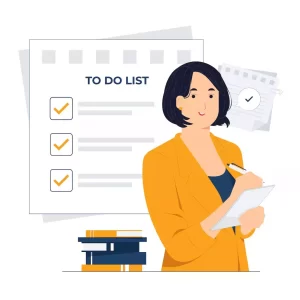
5. Prepare Some Notes
Now, compile all the information you have gathered in the previous step and make a few sparse notes.
Don’t prepare too many flashcards that you end up “reading” your entire interview.
You only need a few notes that you can glance at quickly when you forget something—quick, sharp points and not complete answers.

6. Practice
Seeing your face on your computer screen during an interview can be awkward.
If you have never used standard video interview software before, you should do a mock online interview to familiarise yourself with the features. This step will also help you test your setup.
Ask a friend or your muse career coach to video call you and help you go through the standard interview questions we highlighted before.
They can then give you feedback on the picture quality, shot, sound, internet connection, body language, etc.
Alternatively, record your practice interview and play it back. You can zero in on anything that needs adjusting and make the necessary changes for your next video interview.
During the Interview
You did it.
You have set up your location, picked out an outfit, researched, and made notes. Now, it is time for your interview.
The goal is to convince the recruiter that you are the best person for the job. Here is how to handle this portion of the hiring process:
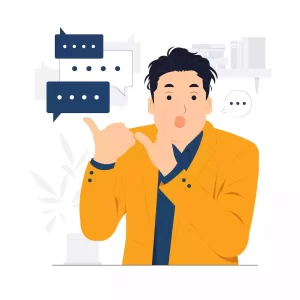
7. Settle In Early
If you had a traditional interview at 9 AM, you would arrive at 8:30 AM. You should also apply this early-bird principle to your video interviews.
Close all the extra tabs and windows on your computer and dedicate your laptop screen to the video interview.
Open any screens you need to share with the recruiter during the meeting, but minimize them if they are stored on the same monitor.
If you have a few minutes, load the video call app and test your connection. You want to be in place several minutes before you press “join the meeting.”
Once everything is in place, do a few breathing exercises to calm yourself.

8. Establish a Connection with the Interviewer
Video interviews eliminate the possibility of a handshake or small talk. Anything that could help you establish a connection with the interviewer.
And while you may be tempted to skip it altogether, not connecting with the interviewer could send the wrong message about your interest in the job.
Once the virtual interview begins, say hello, look right at the interviewer, nod firmly, and smile. This “digital handshake” tells the interviewer you are ready and excited.
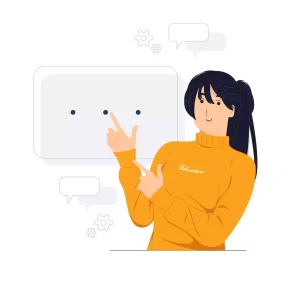
9. Maintain A Good Posture
Your home is where you feel the most comfortable.
But remember that this is a formal job interview.
Avoid slouching in your seat or slumping down, as this could communicate that you are distracted or uninterested.
Instead, place your seat a small distance from the table, keep your feet on the ground, and sit on the edge of your chair with your hands on the table.

10. Use Non-Verbal Communication
You use nonverbal communication, such as nods, body language, eye contact, etc., to supplement what you say in everyday conversations.
This may not be possible in a video interview. The only nonverbal cues you can use in this situation are facial expressions.
And they are essential.
Facial expressions prevent you from looking static. They tell the interviewer you are actively listening and the screen is not frozen.
But how exactly do you go about using them?
You want to avoid vocalizations and mummers of agreement during your video interview.
Only one person’s mic can be active if you and the recruiter use the same platform.
So, vocalizing while they are speaking can cut off the other person’s microphone momentarily.
Instead, use engaged nonverbal communication. Smile and nod as you would in a typical conversation.
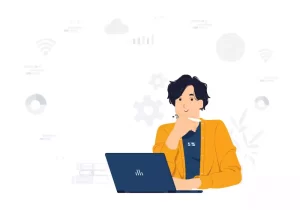
11. Watch Your Body Language
In addition to smiling and nodding, you must watch what you do with your body. For example, you don’t want to nod so much and so often that you look like a bobblehead.
You also want to avoid folding your arms across your body, which can make you appear guarded and defensive. Maintain good posture.
Also, avoid adjusting your hair, fidgeting in your chair, or chewing your nails. Nervous tics are common in such situations but can distract the interviewer.
12. Take Interruptions in Stride
You can never prepare for everything. It is sad, but a fact of life.
So, despite your best efforts to set up the location and tech for your interview, you could face some distractions during the meeting. The key is to take these curveballs in stride.
Recruiters conducting virtual interviews for a while understand that technical difficulties are typical. So, don’t panic. Respond depending on the situation. For instance:
If someone unexpectedly enters the room, apologize and excuse yourself for a few minutes. Then, mute your microphone and deal with the problem.
If noises interrupt the session, such as from an ongoing construction project, apologise for the inconvenience and ask the interviewer to pause the meeting until the noise subsides. You can mute your mic if it is too loud.
- If the video cuts out, call the interviewer at the number they provided you in the interview invitation email. Ask if you can reschedule or have the interview over your mobile phone.

13. Don’t Interrupt the Interviewer
Never interrupt the interviewer, no matter how excited you are about the interview.
As mentioned, most common video call platforms only allow one mic to function simultaneously.
So, if you begin responding before the interviewer is done talking, you can mute their mic and miss critical information. You may also appear rude, even if it was not your intention.
Let the other person finish speaking, pause momentarily, and then respond.

14. Signal When You Are Done
Similarly, most interviewers will only jump in once you are done. They know doing so can cut off the other person’s mic.
So, it is up to you to notify them that you are done speaking. You can do this by nodding, asking them questions, or using an actionable conclusion.
Video Interview Dos and Don’ts
Dos
- Say so if you wish to pause to write notes or think about the question.
- Keep the interviewer aware of what you are doing so they don't think they have lost the connection.
Don'ts
- Don't murmur or hum during silences if the interviewer needs to communicate something.
- Don't interrupt; wait for the interviewer to finish speaking.

15. Have a Conversation with the Interviewer
Leave the interviewer feeling like they just had a good conversation with a friend. A friend they want to hire.
After the Interview
You have come to the end of the video interview.
Thank the interviewer for their time and ask when you should expect to hear from them. It seems bold, but this might be the take-charge attitude that gets you the job.
Later, you can send the interviewer a professional thank-you email as a follow-up.
You can also go through the meeting in your mind and determine how to improve your digital interviewing skills even further for your subsequent video interview.
Video Interview Tips: What Are Employers Looking for in a Video Interview?
All the online video interview tips worldwide will only matter if you know what the interviewer is looking for in a virtual interview. Essentially, they want you to:
- Be Creative: Recruiters want to see creativity and innovation in how you answer questions, handle technical difficulties, and present yourself. You should aim to please.
- Answer the Questions Asked: Just because you prepared for a specific set of questions does not mean the interviewer will ask them. It is good to prepare beforehand, but you should also be ready for anything. Be adaptable. Answer the question you have been asked, not the one you wish had been asked.
- Prove Your Qualifications: You must present your CV and cover letter to prove you are suitable for the job. You can use our Online CV Builder to create a winning CV.
- Be presentable, well-groomed, and well-dressed.
What Are The 3 Mistakes Candidates Make During the Video Interview?
Video interviews are quickly becoming the norm. But they weren’t always.
This means that job seekers often have to learn from their mistakes. Here are some you should avoid:
- Not Establishing a Connection: Never think of your interview as a question you must fill in with technical answers. A video interview is a conversation. You can land that job better if you build rapport with the recruiter.
- Not Practicing Common Interview Questions: We have already established that you cannot anticipate what the interviewer will ask. But it would be suicidal to go in unprepared. Research the company, read the job description, and reflect on your responses.
- Using a Messy Background: If you walk into an in-person interview to find a messy office with broken chairs, you may not want the job so much after all. The same principle applies to video interviews; only you are on the spot. If you cannot find a neat, neutral background for your video calls, rent an office space.
What Should You Avoid in A Video Interview?
In addition to avoiding the common virtual interview pitfalls, here are some video call no-nos you should steer clear of:
- Being Overly Casual: You are at home. You will be tempted to answer video calls in your pyjamas, lean back on your couch, and talk when the mood strikes. But despite the setting, a video interview is a professional assessment of your ability to perform a role. You should treat it like any other interview.
- Skipping the Tech Test: Even a tech genius will test their equipment before using it. Don’t put off setting up and testing your setup until minutes before the interview. You may not have time to fix the tech difficulties you discover.
- Interrupting the Interviewer: If only one mic can work simultaneously, you must be careful when speaking. Cutting off the interviewer can be detrimental to your chances of getting hired.
What Not to Say During a Video Interview
What you say in a video interview will depend on what the interviewer asks you, your personality, your experience, and more. But here are some things you should never say:
- If you are interviewing for a promotion or a different role in the same company, do not badmouth your colleagues or supervisors
- Don’t exaggerate, lie, or embellish your skills
- Don’t swear if you encounter a technical hitch or interruption
- Don’t use filler words like “uh-huh” and “Ummm.”
Live Vs. Pre-Recorded Video Interviews
Like phone interviews, video interviews allow you to correspond with the interviewer in real-time. Sometimes, however, a company will administer a pre-scripted digital interview.
This is where you listen to pre-recorded interview questions and then record and send your answers for the interviewer to review later.
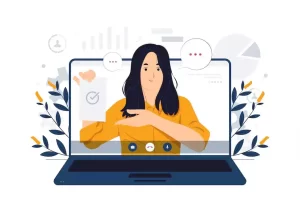
How Do I Pass a Pre-Recorded Video Interview?
As with any interview, it is good life advice to prepare for your pre-recorded interview beforehand.
Use all the tips we have discussed so far and incorporate the following additional pointers into your approach:
- Never jump ahead. Watch the entire recording so you do not miss critical information.
- Check how many attempts you are allowed for every question.
- Listen carefully to the interview instructions, note the required preparation, and record the time for all the questions.
Key Takeaways
- Always prepare for a video interview as you would any interview. Research the company, read the job description, and practice common interview questions.
- When setting up the interview location, look for a quiet area of your home with a neutral backdrop, plenty of natural light, and few distractions.
- Before the interview, log in early and test your setup – internet connection, frame, position, shot, sound, etc.
- During the interview, relax, be yourself, maintain good posture, use facial expressions, and converse with the interviewer.
- Whatever you do, don’t interrupt the interviewer.
Ace That Video Interview Like a Pro
You did it.
You now know the basics of setting up and crushing your virtual interview.
You can set up a spectacular location, test your software, deal with distractions, and answer common interview questions. But that is not enough.
More and more companies are using video interviews as a recruitment tool. And with more job seekers knowing how to navigate them, you need more than just the basics.
You need the icing on the cake, which is your personality.
As in any interview, the only way to ace your video interview is to charm the interviewer.
Relax, be confident, and prove you are the best person for the job.
In a career podcast, Adrean’s words,
Stay FIT. Be Fearless, Be Inspired, and Be Transformed.
Use any interruptions or hitches that occur to show the interviewer that you are adaptable, creative, and a problem solver.
Essentially, make every aspect of your video interview part of your CV.
The interviewers won’t know what hit them.
All the best and happy interviews!
